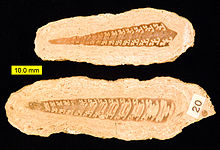Oncolite


Oncolites are sedimentary structures composed of oncoids, which are layered structures formed by cyanobacterial growth. Oncolites are very similar to stromatolites, but, instead of forming columns, they form approximately spherical structures.[1] The oncoids often form around a central nucleus, such as a shell fragment,[2] and a calcium carbonate structure is deposited by encrusting microbes. Oncolites are indicators of warm waters in the photic zone, but are also known in contemporary freshwater environments.[3] These structures rarely exceed 10 cm in diameter.
Oncolites may have either a porostromate or spongiostromate texture. Most oncolites are spongiostromate, having no recognisable cellular texture or microstructure. Porostromate oncolites are mostly unknown during the Precambrian; since the Eocene they have mostly been confined to freshwater environments.[4]
Distribution
[edit]The appearance of recent or near-recent freshwater oncoids has been documented in two rivers in Bavaria: the Alz, whose source is the Chiemsee, and the Moosach, near Freising.[5][6][7] Modern oncoids also grow in some springs in Atacama Desert in South America. In one particular case a system of oncoids have been observed interface between Salar de Antofalla and an adjacent wetland.[8]
References
[edit]- ^ Corsetti, F.A.; Awramik, S.M.; Pierce, D. (2003-04-15). "A complex microbiota from snowball Earth times: Microfossils from the Neoproterozoic Kingston Peak Formation, Death Valley, USA". Proceedings of the National Academy of Sciences. 100 (8): 4399–4404. Bibcode:2003PNAS..100.4399C. doi:10.1073/pnas.0730560100. PMC 153566. PMID 12682298.
- ^ Gutschick, R.C.; Perry, T.G. (1959-11-01). "Sappington (Kinderhookian) sponges and their environment [Montana]". Journal of Paleontology. 33 (6): 977–985. Retrieved 2007-06-28.
- ^ Riding, Robert. 1991. Calcareous Algae and Stromatolites, pp. 32. Springer-Verlag Press.
- ^ Monty, C. L. (1981). "Spongiostromate vs. Porostromate Stromatolites and Oncolites". In Monty, Claude (ed.). Phanerozoic Stromatolites. Berlin, Heidelberg: Springer. pp. 1–4. doi:10.1007/978-3-642-67913-1_1. ISBN 978-3-642-67913-1.
- ^ D. Hägele (2006), Morphogenese, Wachstum und Ökologie der modernen Süßwasser-Onkoide der Alz (Online-Version; pdf-Datei; 8,6 MB) (in German), Dissertation an der Fakultät für Geowissenschaften, Ludwig-Maximilians-Universität München
- ^ E. Rott (1994), "Der Algenaufwuchs in der Oberen Alz (Oberbayern)" (Online-Version; pdf-Datei; 7,6 MB), Berichte des Naturwissenschaftlich-medizinischen Vereins in Innsbruck (in German), vol. 81, Innsbruck, pp. 229–253
- ^ N.N. (2008), "Stop 7: Tufa oncoids of the river Moosach, Molasse Basin" (Online-Version; pdf-Datei; 8,4 MB), Geobiology of Stromatholites - Internationales Kalkowsky-Symposium (in German), Göttingen, pp. 193–197
- ^ Villafañe, Patricio Guillermo; Lencina, Agustina Inés; Soria, Mariana; Saona, Luis Alberto; Gómez, Fernado Javier; Alonso, Guido Ezequiel; Farías, María Eugenia (2021-05-01). "Las Quínoas oncoids: a new deposit of microbialites in the Salar de Antofalla (Catamarca, Argentina)". Andean Geology. 48 (2): 281–302. doi:10.5027/andgeoV48n2-3292. hdl:11336/148257. S2CID 235877492.
